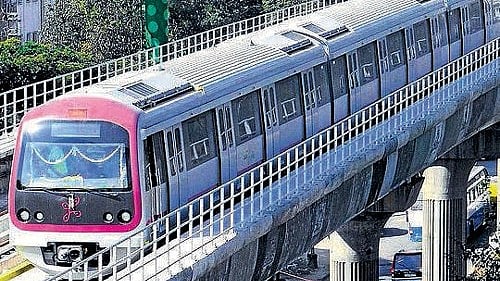
Namma Metro.
Credit: DH File Photo
Bengaluru: Banashankari temple, the Geological Survey of India (GIS), the National Council of Educational Research and Training (NCERT), PES University, a BMTC bus depot and a burial ground are among the establishments that will part with land for Namma Metro's Phase 3, according to data accessed by DH.
Delmia flyover, a landmark in JP Nagar, will also make way for the new metro line. Other flyovers along the western stretch of the Outer Ring Road (ORR) will be integrated into a new double-deck flyover, said M Maheshwar Rao, Chief Commissioner, BBMP.
The 44.8-km Phase 3, also called the Orange Line, will connect the ORR's western stretch and further extend connectivity along Magadi Road. Slated for completion in 2029, it will expand Bengaluru's metro network to 222.2 km.
The Japan International Cooperation Agency (JICA) has agreed to provide Rs 6,770 crore for the project and is expected to sign an agreement by March 31, 2026, a Bangalore Metro Rail Corporation Limited (BMRCL) official with direct knowledge of the matter said. JICA's funding will cover both civil and systems work.
The land requirement for two corridors under Phase 3 has increased by over 70,000 sqm due to the double-decker plan. While the DPR estimated the land requirement at 5,98,528 sqm, the BMRCL will now need 6,72,117 sqm.
"Land acquisition for metro projects is usually linear. But since this phase includes a double-deck flyover, additional land will be required on either side. The viaduct will be wider than usual," another official explained, speaking on the condition of anonymity.
Most of the land will come from front portions of properties that also include residential buildings, choultries and small hospitals.
PES University will lose its entrance arch, while Banashankari Temple will part with about three acres of vacant land.
The Revenue Department will give up 4,594 sqm in Hosakerehalli, including a portion of a burial ground.
"The project will mostly impact properties with little or no setback," the official said.
The BMRCL has divided Corridor 1 (JP Nagar 4th Phase to Kempapura, 32.65 km) into three packages to streamline land acquisition.
Package 1 (JP Nagar 4th Phase to Mysuru Road, 10.88 km) will need 415 properties spread over 67,601 sqm. Of this, the final notification has been published for 198 of these properties.
For Package 2 (Mysuru Road to Kanteerava Studio, 10.6 km), a ground survey is underway to identify the necessary properties.
Package 3 (Kanteerava Studio-Kempapura, 10.67 km) will need 282 properties spread over 1,11,351 sqm. Of this, the final notification has been issued for 85 properties, the official noted.
The BMRCL, which expects to complete land acquisition in 3-4 months, has its own formula to determine compensation.
A price fixation committee calculates the land value based on the average of the last 50 transactions in the past three months or the guidance value — whichever is higher — and then adds a 100% solatium to arrive at the final compensation.
Despite all statutory clearances for Phase 3, land acquisition and construction were delayed due to the double-decker plan. The Detailed Design Consultant (DDC) report is not ready either.
The cost of building the double-decker has increased from Rs 8,912 crore to Rs 9,612 crore due to additional scope of work, the official said. "The state government will bear the entire cost. It's their baby," he added.
The first official said land acquisition would not affect construction. "Civil work tenders will be floated by August-end and will take three months to finalise. "We'll have the land by then," he said.
Phase 3 will have 30 stations (21 in Corridor 1 and 9 in Corridor 2). Seven of these will be interchange stations (JP Nagar 4th Phase, JP Nagar, Mysuru Road, Sumanahalli Cross, Goraguntepalya, Hebbal and Kempapura).